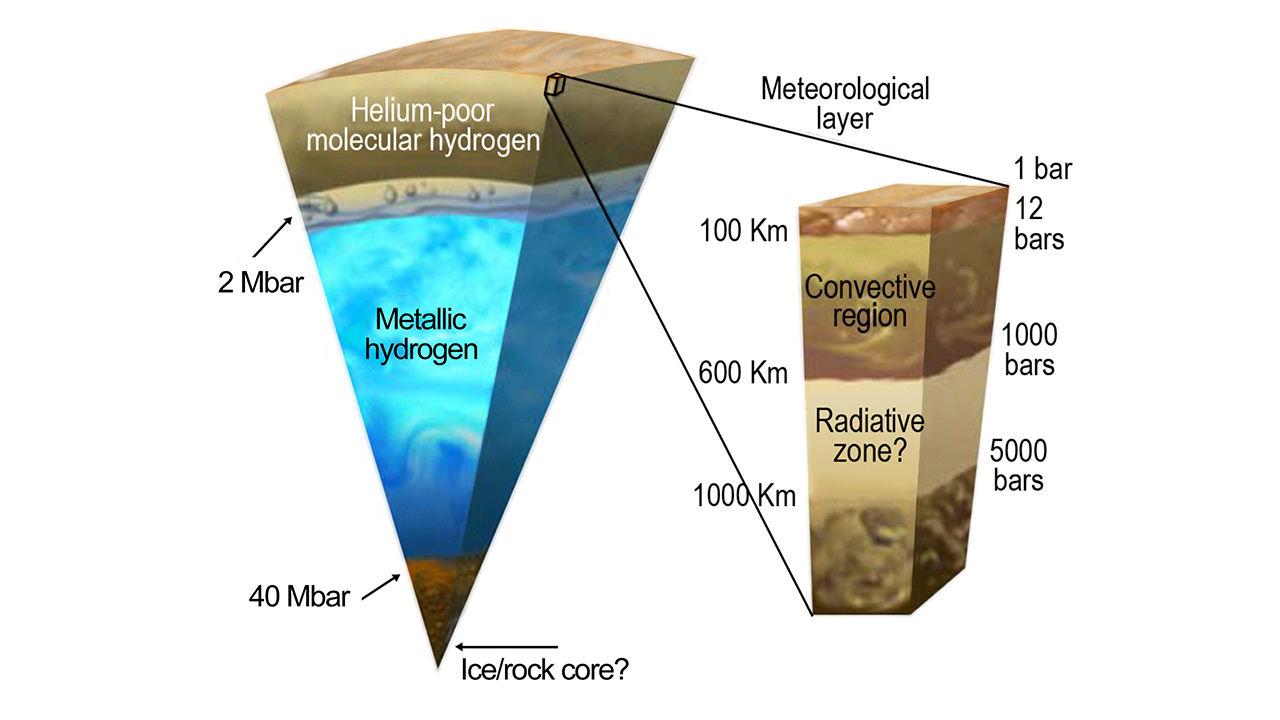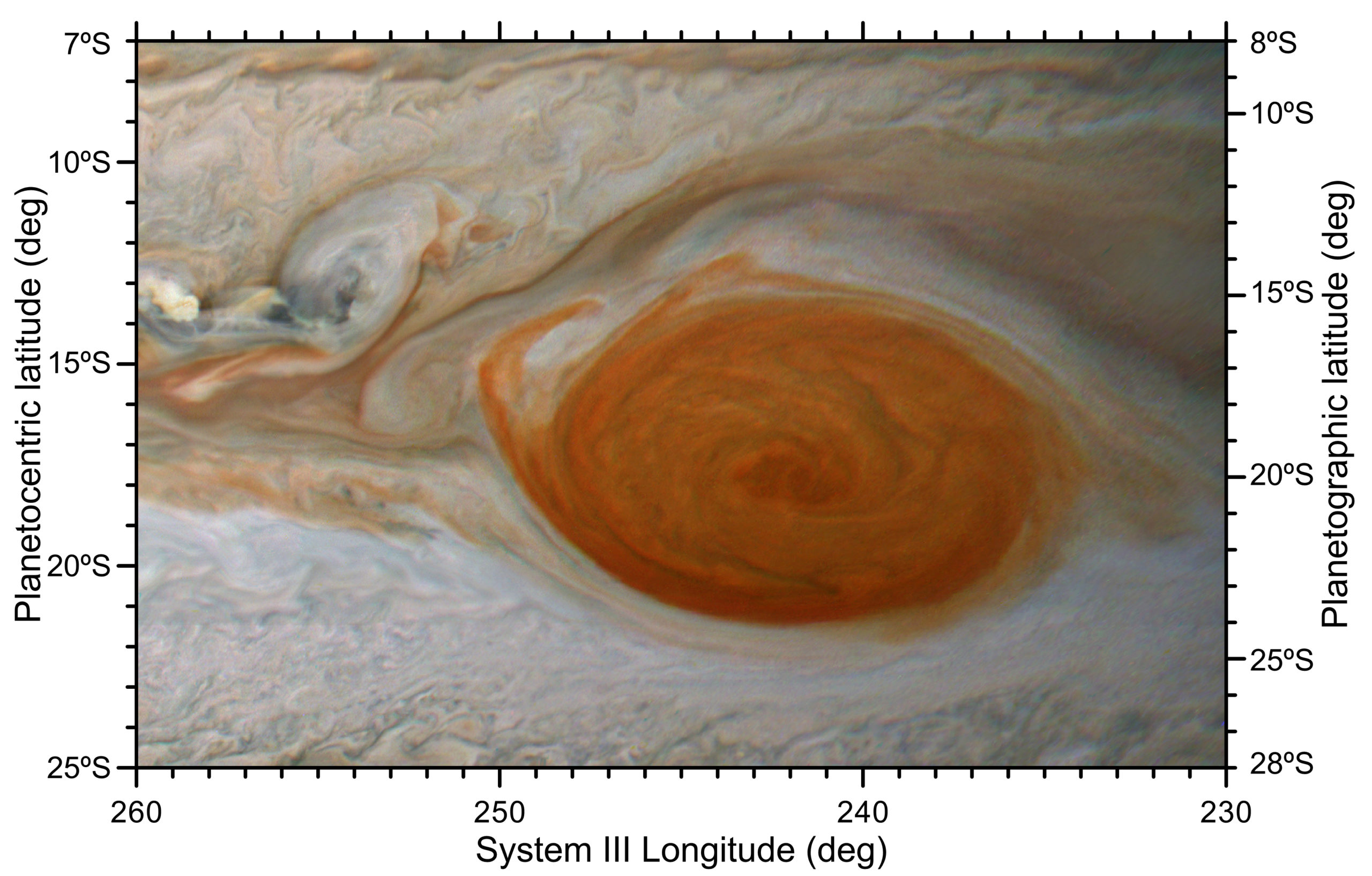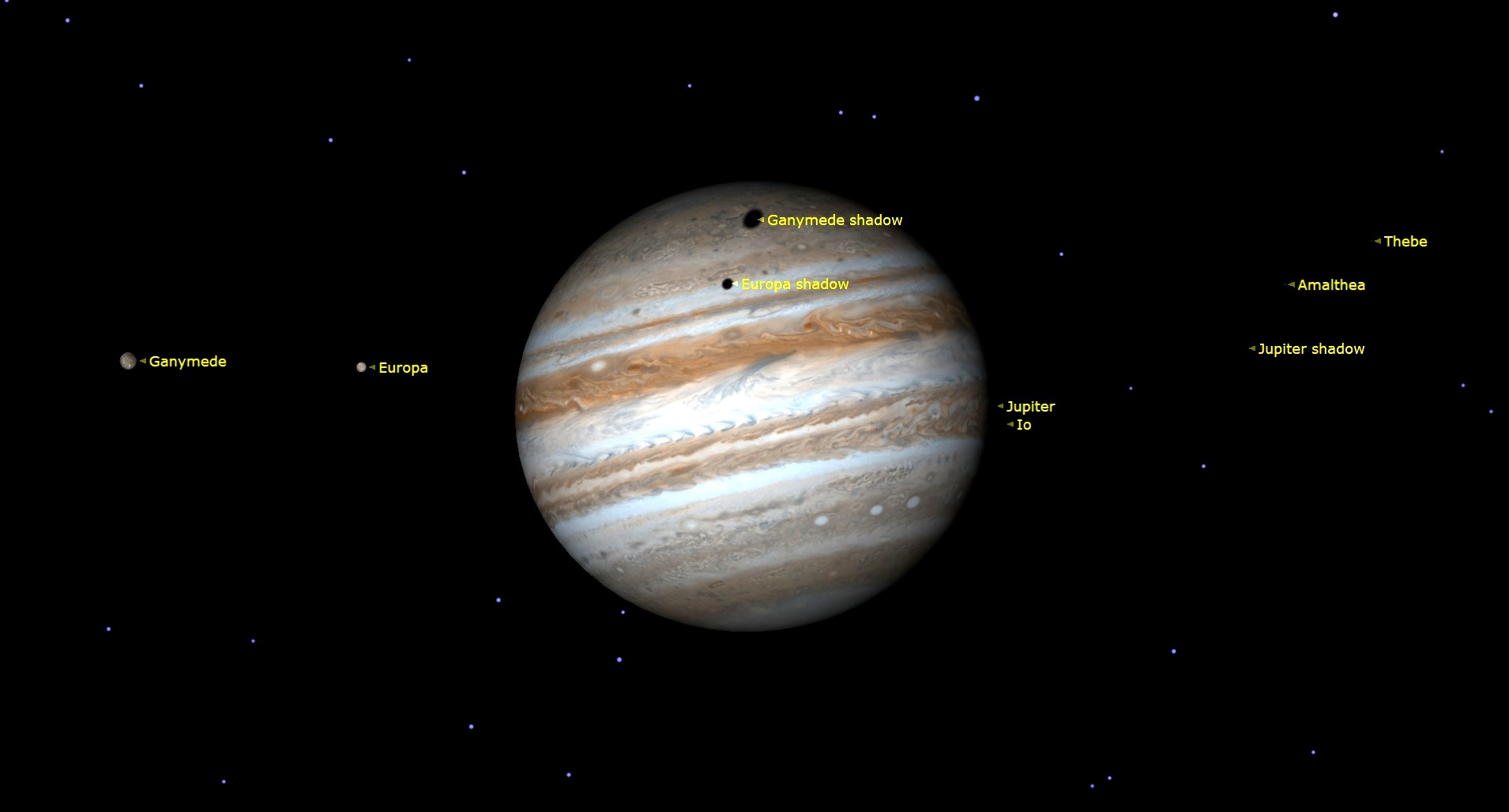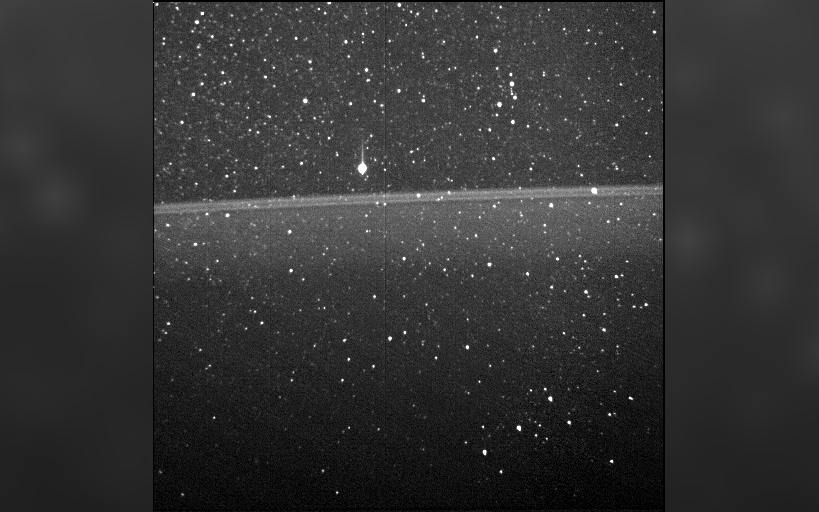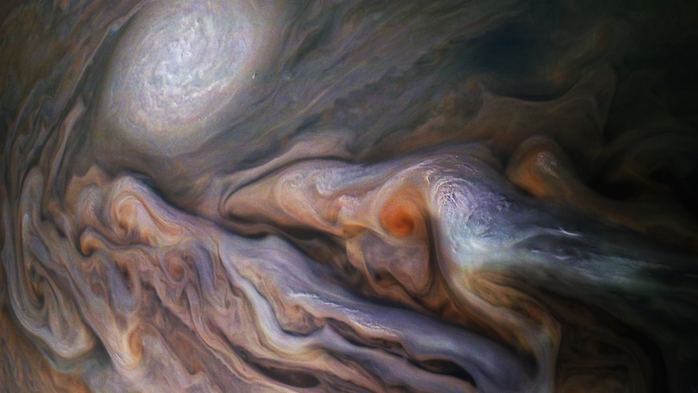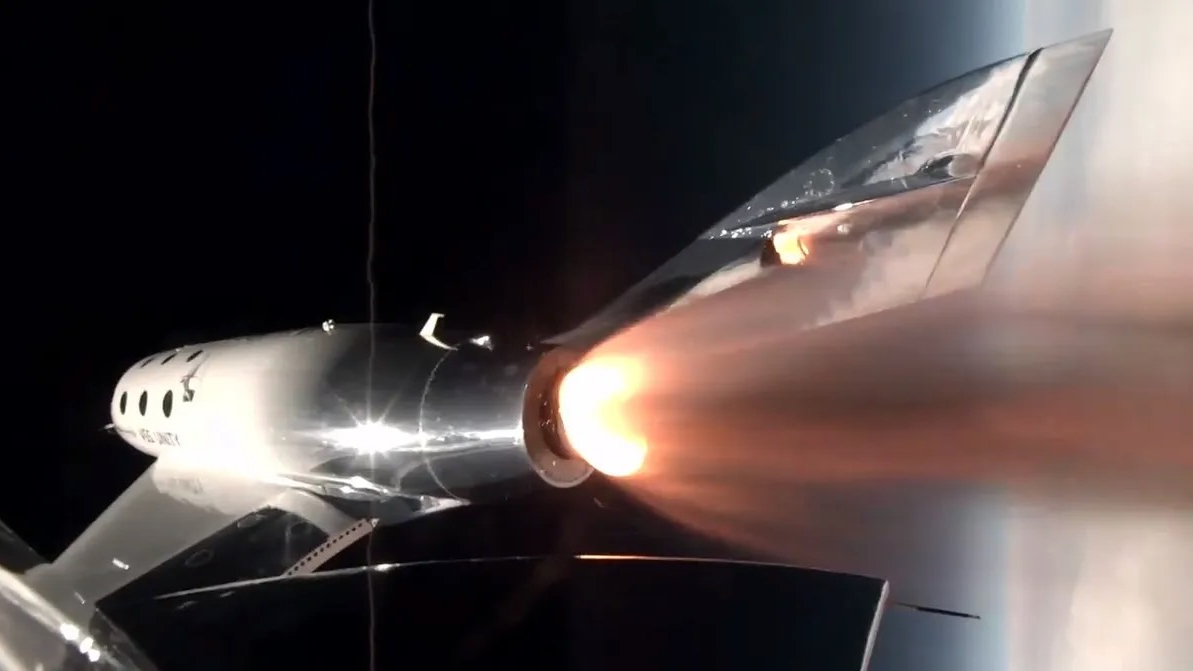Jupiter: A guide to the largest planet in the solar system
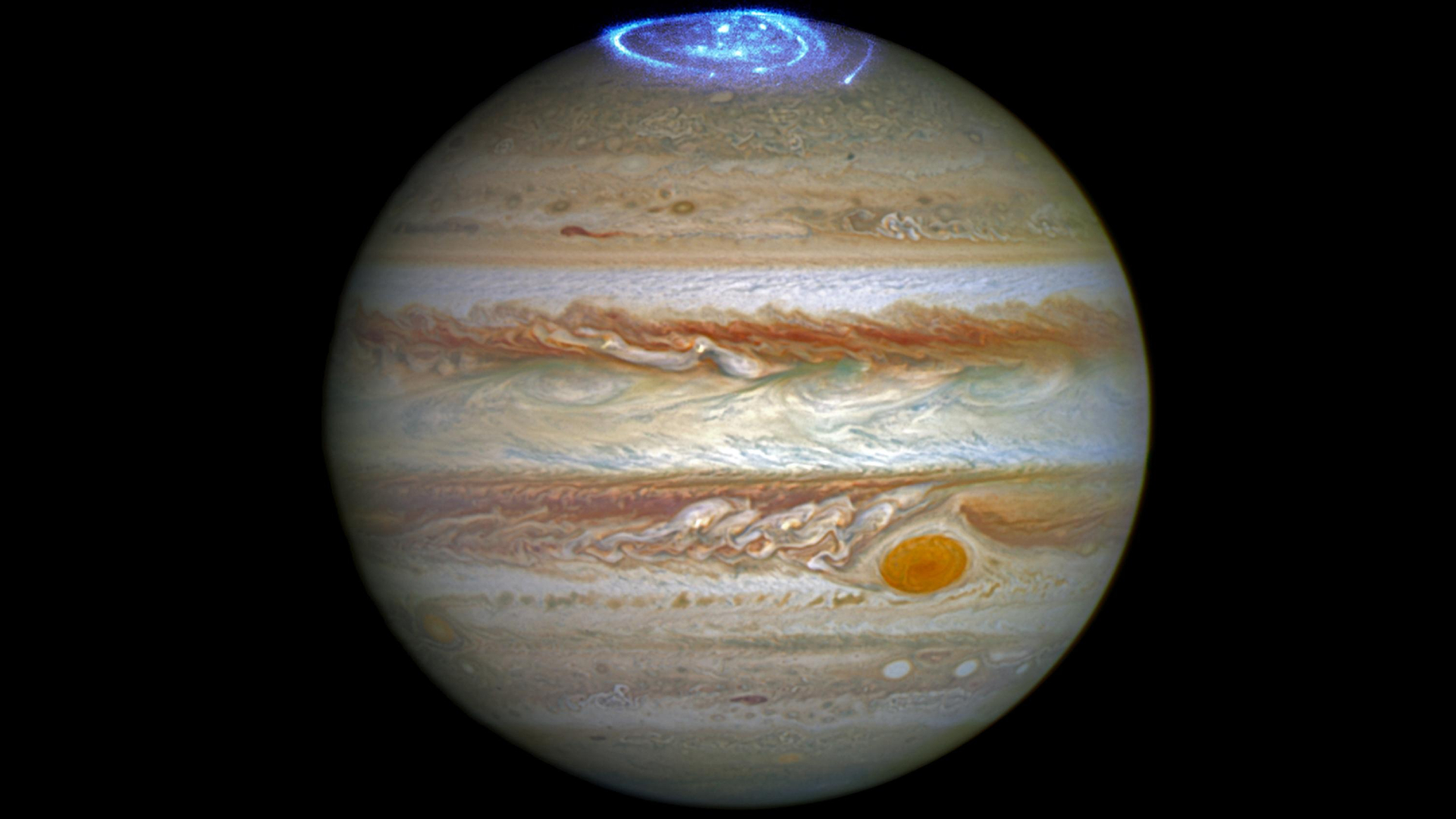
Jupiter is the largest planet in the solar system and the fifth planet from the sun. The gas giant has a long, rich, history of surprising scientists.
Named after the kind of the gods in Roman mythology this "king of the planets" is a stormy enigma shrouded in colorful clouds. Its most prominent and most famous storm, the Great Red Spot, is twice the width of Earth.
Since 2016, the NASA spacecraft Juno has been investigating Jupiter and its moons.
Related: Gas giants: Jovian planets of our solar system and beyond
When was Jupiter discovered?
Jupiter helped to revolutionize the way we saw the universe — and our place in it — in 1610 when Galileo discovered Jupiter, along with its four large moons: Io, Europa, Ganymede and Callisto.
These observations were the first time that celestial bodies were seen circling an object other than Earth and supported the Copernican view that Earth was not the center of the universe.
How big is Jupiter?
Jupiter is more than twice as massive as all the other planets combined, according to NASA. Jupiter's immense volume could hold more than 1,300 Earths. If Jupiter were the size of a basketball, Earth would be the size of a grape.
Breaking space news, the latest updates on rocket launches, skywatching events and more!
Jupiter was probably the first planet to form in the solar system, made up of gasses left over from the formation of the sun. If the planet had been about 80 times more massive during its development, it would have actually become a star in its own right, according to NASA.
Related: How big is Jupiter?
How far is Jupiter from the sun?
On average, Jupiter orbits at about 483,682,810 miles (778,412,020 kilometers) from the sun. That's 5.203 times farther than Earth's average distance from the sun.
At perihelion, when Jupiter is closest to the sun, the planet is 460,276,100 miles (740,742,600 km) away.
At aphelion or the farthest distance that Jupiter reaches from the sun, it is 507,089,500 miles (816,081,400 km) away.
Does Jupiter have a solid surface?
Jupiter is a gas giant planet, as such it does not have a true solid surface. A spacecraft would not be able to land on the giant planet nor could it fly right through unscathed due to the crushing pressures and extreme temperatures it would experience during its journey.
Jupiter FAQs answered by an expert
We asked Leigh Fletcher, a professor of planetary science a few commonly asked questions about Jupiter.
Is Jupiter a gas planet?
Yes, but don't be fooled into thinking that Jupiter is like a big cloud of gas that you could fly through, it's more like a fluid planet that gets denser and hotter the deeper you go.
Pressures at the colorful cloud tops are not dissimilar to those in Earth's atmosphere, but they build up as you go deeper, rather like a submarine experiencing crushing densities as it sinks deeper and deeper into our oceans. In fact, the hydrogen that is Jupiter's dominant gas gets compressed to such extremes that it changes to an exotic metallic hydrogen form. So think of Jupiter as a bottomless ocean of strange, exotic materials.
What is the Great Red Spot on Jupiter?
Jupiter's famous Great Red Spot is a swirling vortex — technically an anticyclone because it rotates anticlockwise in Jupiter's southern hemisphere. This vortex is big enough to swallow the Earth twice over, and the winds that whip around its edges do a good job of keeping the calm air inside the vortex separated from turbulent, stormy air outside.
The calm air in the interior gets cooked by the ultraviolet light from the sun, creating chemicals and hazes that are very good absorbers of blue light, leaving only red light to be reflected back towards an observer. The Great Red Spot has been around since at least the Victorian era, almost two centuries ago, but has been steadily shrinking in east-west extend for much of that time.
Is there a planet bigger than Jupiter?
Almost certainly, but not here in our solar system. Jupiter and Saturn are the big Gas Giants, Uranus and Neptune are more "intermediate-sized" Ice Giants, whereas the rocky terrestrial planets are much smaller. When we look out at the incredible range of exoplanets being discovered around other stars, more than 5000 at the last count, we do see evidence for larger planets, some of which are "puffed up" because they're really close to their parent stars and getting a lot of energy from them to heat their atmospheres to thousands of degrees.
Why is Jupiter sometimes called a "failed star"?
Jupiter and the other giant planets are essentially made of the same stuff as the sun, albeit with a few changes to the basic ingredients beyond hydrogen and helium. So give them a lot more material to start with, and they could ignite nuclear fusion of their hydrogen to form helium, therefore becoming a star. But brown dwarfs sit in between giant planets and main-sequence stars, too small and light to burn hydrogen, but possibly heavy enough to burn deuterium via nuclear fusion, when they're about 13 times more massive than our Jupiter.
Jupiter's environment
Jupiter's atmosphere resembles that of the sun, made up mostly of hydrogen and helium. A helium-rich layer of fluid metallic hydrogen envelops a “fuzzy” or partially-dissolved core at the center of the planet.
The colorful light and dark bands that surround Jupiter are created by strong east-west winds in the planet's upper atmosphere traveling more than 335 mph (539 km/h). The white clouds in the light zones are made of crystals of frozen ammonia, while darker clouds made of other chemicals are found in the dark belts. At the deepest visible levels are blue clouds. Far from being static, the stripes of clouds change over time.
Inside the atmosphere, diamond rain may fill the skies, and hidden deep within the atmosphere is a dense core of unknown composition.
Jupiter's gargantuan magnetic field is the strongest of all the planets in the solar system, at nearly 20,000 times the strength of Earth's, according to the University of Colorado at Boulder. The magnetic field traps electrons and other electrically charged particles in an intense belt that regularly blasts the planet's moons and rings with radiation more than 1,000 times the level lethal to a human. The radiation is severe enough to damage even heavily shielded spacecraft, such as NASA's Galileo probe. The magnetosphere of Jupiter swells out some 600,000 to 2 million miles (1 million to 3 million km) toward the sun and tapers to a tail extending more than 600 million miles (1 billion km) behind the massive planet.
Does Jupiter have rings?
The star-tracker camera aboard NASA’s Juno spacecraft captured this view of Jupiter's faint rings on Aug. 27, 2016, during the probe's first data-gathering close approach to the giant planet. It’s the first-ever view of the planet's rings from inside of them. The bright star above the main ring is Betelgeuse, and Orion’s belt can be seen in the lower right.
What is the Great Red Spot?
One of Jupiter's most famous features is the Great Red Spot, a giant hurricane-like storm that's lasted more than 300 years. According to NASA, the Great Red Spot at its widest is about twice the size of Earth, and its edge spins counterclockwise around its center at speeds of about 270 to 425 mph (430 to 680 kph). That counterclockwise spin makes it a type of storm called an "anticyclone."
The color of the storm, which usually varies from brick red to slightly brown, may come from small amounts of sulfur and phosphorus in the ammonia crystals in Jupiter's clouds. The spot has been shrinking for quite some time, although the rate may be slowing in recent years.
Jupiter has many other storms, too. According to 2022 data from Juno, Jupiter's gargantuan polar cyclones are driven by convection or heat rising from lower altitudes to the higher atmosphere, similar to the way ocean vortexes work on Earth.
Jupiter's moons
Jupiter has a mind-boggling 79 known moons, mostly named after the paramours and descendants of the Roman god of the same name. The four largest moons of Jupiter called Io, Europa, Ganymede and Callisto, were discovered by Galileo Galilei and so are sometimes called the Galilean moons.
Related: Jupiter's moons: Facts about the many moons of the Jovian system
Ganymede is the largest moon in our solar system, and is larger than both Pluto and Mercury. It is also the only moon known to have its own magnetic field, whose eerie sound NASA's Juno mission captured in 2021. The moon has at least one ocean between layers of ice, although according to a 2014 study from the journal Planetary and Space Science, it may contain several layers of ice and water stacked on top of one another, along with atmospheric water vapor first spotted in 2021. Ganymede will be the main target of the European Jupiter Icy Moons Explorer (JUICE) spacecraft scheduled to launch in 2023 and arrive at Jupiter's system in 2030.
Io is the most volcanically active body in our solar system. As Io orbits Jupiter, the planet's immense gravity causes "tides" in Io's solid surface that rise 300 feet (100 meters) high and generate enough heat to spur on volcanism. Those volcanoes release more than one ton of material every second into the space around the moon, helping to create strange radio waves from Jupiter. The sulfur its volcanoes spew gives Io a blotted yellow-orange appearance, leading some to compare it to a pepperoni pizza.
The frozen crust of Europa is made up mostly of water ice, and it may hide a liquid ocean that contains twice as much water as Earth's oceans do. Some of this liquid spouts from out of Europa's southern pole in sporadic plumes, and in 2021 the Hubble Space Telescope spotted more water vapor above Europa's surface. Also in 2021, Europa's north pole was photographed for the first time, and the discovery of underwater volcanoes raised hopes that Europa could be hospitable to life.
With the National Oceanic and Atmospheric Administration (NOAA) and the Woods Hole Oceanographic Institute, NASA may someday send an autonomous submersible to explore Europa's ice-covered oceans. Additionally, NASA's Europa Clipper mission, a planned spacecraft that would launch in the 2020s, would perform 40 to 45 flybys to examine the habitability of the icy moon.
Callisto has the lowest reflectivity, or albedo, of the four Galilean moons. This suggests that its surface may be composed of dark, colorless rock. Once considered a boring counterpart to the other Galilean moons, Callisto's heavily-cratered surface might conceal a secret ocean, according to NASA.
Jupiter's rings
Jupiter's three faint rings came as a surprise when NASA's Voyager 1 spacecraft discovered them around the planet's equator in 1979. Much more tenuous than Saturn's chunky, colorful rings, Jupiter's rings are made of continuous streams of dust particles emitted by some of the planet's moons, according to NASA's Goddard Space Flight Center.
The main ring is flattened, according to the Southwest Research Institute's (SwRI's) Juno Mission website. It is about 20 miles (30 km) thick and more than 4,000 miles (6,400 km) wide.
The inner donut-shaped (also called “toroidal”) ring, called the halo, is more than 12,000 miles (20,000 km) thick, wrote SwRI. The halo is caused by electromagnetic forces that push grains away from the plane of the main ring. Both the main ring and halo are composed of small, dark particles of dust.
The third ring, known as the gossamer ring because of its transparency, is actually three rings of microscopic debris from three of Jupiter's moons: Amalthea, Thebe and Adrastea. According to a press release from NASA's Galileo mission, the gossamer ring is probably made up of dust particles about the same size as the particles found in cigarette smoke, and extends to an outer edge of about 80,000 miles (129,000 km) from the center of the planet and inward to about 18,600 miles (30,000 km).
Ripples in the rings of both Jupiter and Saturn may be signs of impacts from comets and asteroids.
Exploring Jupiter
NASA's Juno mission arrived at Jupiter in 2016 with an intended lifespan of about 20 months in orbit, but as of 2022 continues to return beautiful images, audio and other data, with its mission extended until 2025.
— Jupiter's auroras arise from a magnetic 'tug-of-war' with volcanic eruptions on its moon Io
— Happy birthday, Juno! NASA's Jupiter probe launched 10 years ago today
— NASA's Juno spacecraft spots 'sprites' and 'elves' dancing in Jupiter's atmosphere
— Behold! Jupiter is a breathtaking 'marble' in this NASA Juno photo
Historically, nine missions have flown by Jupiter — seven have flown past, Pioneer 10, Pioneer 11, Voyager 1, Voyager 2, Ulysses, Cassini and New Horizons. Only two missions — NASA's Galileo and Juno — have orbited the planet.
Related: Jupiter missions: Past, present and future
Pioneer 10 revealed how dangerous Jupiter's radiation belt is, while Pioneer 11 provided data on the Great Red Spot and close-up pictures of Jupiter's polar regions. Voyagers 1 and 2 helped astronomers create the first detailed maps of the Galilean satellites, discovered Jupiter's rings, revealed sulfur volcanoes on Io and detected lightning in Jupiter's clouds. Ulysses discovered that the solar wind has a much greater impact on Jupiter's magnetosphere than scientists previously thought. New Horizons took close-up pictures of Jupiter and its largest moons.
Jupiter's first orbiter, Galileo, arrived in 1995 and soon sent a probe plunging toward Jupiter, making the first direct measurements of the planet's atmosphere and measuring the amount of water and other chemicals there. Then the main spacecraft spent eight years studying the system. When Galileo itself ran low on fuel, the spacecraft intentionally crashed into Jupiter to avoid any risk of it bringing contamination from Earth to Europa, which might have an ocean below its surface capable of supporting life.
Now, Juno studies Jupiter from a polar orbit, in part to figure out how it and the rest of the solar system formed. Researchers hope the mission could also shed light on how alien planetary systems might have developed. According to data from Juno, Jupiter's core may be larger than scientists expected, while Jupiter's stripes and storms stretch from high in the atmosphere to deep inside the planet. In a 2021 NASA overview of Juno's biggest hits, the agency also included observing lightning on Jupiter, detecting water in the atmosphere and measuring magnetic fields 10 times stronger than any found on Earth.
Although no missions dedicated to Jupiter itself are in the works, two future spacecraft will study Jupiter's moons: NASA's Europa Clipper (which would launch in the mid-2020s) and the European Space Agency's Jupiter Icy Moons Explorer (JUICE) which will launch in 2023 and arrive at Jupiter's system in 2030 to study Ganymede, Callisto and Europa.
Researchers say that the gas giant will also be a "proving ground" for the James Webb Space Telescope (JWST). Scientists are eager to explore Jupiter during the first year of scientific observations of the powerful telescope. With Webb's sights set on exploring Jupiter and its moons scientists are excited at the prospect of understanding some of Jupiter's greatest mysteries such as how such a massive storm — the Great Red Spot — forms in the turbulent atmosphere or how its largest moons may harbor oceans of water of hidden volcanoes.
On July 14, 2022, the JWST team released a few tantalizing photos of Jupiter that were captured during the commissioning period. In some of the images, Jupiter's thin ring structure and its moons Europa, Thebe and Metis, are captured through JWST's NIRCam.
How did Jupiter shape our solar system?
As the most massive body in the solar system after the sun, Jupiter has helped shape the fate of our neighborhood in space with its immense gravity.
Jupiter's gravity has been found responsible for slinging Neptune and Uranus (along with a host of smaller objects like asteroids) away from the sun, according to a 2005 paper published in the journal Nature. That paper established a theory of "planetary genealogy" called the Nice model, named after the French city where it was developed.
According to the Nice model, Jupiter and other gas giants were also responsible for the Late Heavy Bombardment, a period of time when the young planet Earth and its nearby fellows were barraged with debris.
Nowadays, Jupiter may help keep asteroids and comets from bombarding Earth, protecting the inner planets by acting as the "vacuum cleaner of the solar system," wrote SwRI. Its enormous gravity can suck in and absorb smaller objects — as with the spectacular 1994 collision of Jupiter and Comet Shoemaker-Levy 9 — or propel them out of the solar system entirely. But that same gravity can still accelerate some of those objects toward the inner planets, too, so it's a mixed blessing.
Could there be life on Jupiter?
Jupiter's atmosphere grows warmer with depth, reaching room temperature, or 70 degrees Fahrenheit (21 degrees Celsius), at an altitude where the atmospheric pressure is about 10 times as great as it is on Earth. Scientists suspect that if Jupiter has any form of life, it would have to be airborne at this level. Theoretically, a 2021 study found, that there is enough water to support some life. However, researchers have found no evidence of life on Jupiter.
Jupiter's moons are a different story: Europa in particular could host a radiation-shielded hidden ocean, and marine life might float somewhere in those alien waters.
Additional resources and reading
Read this 2018 interview from PBS NewsHour with JunoCam’s lead scientist Candice Hansen-Koharchek, who connects the camera aboard NASA's Juno mission to the public and lets anyone participate in the science around Jupiter. For more on Jupiter's possible past as a major mover-and-shaker in the solar system, read this overview article published in 2020 by the journal Proceedings of the National Academy of Sciences that discusses both the Nice model and newer theories of Jupiter's history. Writer Marina Koren discovers that Jupiter's Great Red Spot might actually be more of a pale rosy color in this piece from The Atlantic on the true colors of the solar system. And for an in-depth video look at the solar system's biggest planet, check out the Jupiter episode of NOVA's "The Planets" series, narrated by actor Zachary Quinto.
Bibliography:
- Barnett, Amanda. "In Depth | Callisto." NASA Solar System Exploration. Accessed Feb. 4, 2022. https://solarsystem.nasa.gov/moons/jupiter-moons/callisto/in-depth.
- Ibid. "Jupiter." NASA Solar System Exploration. Accessed Feb. 3, 2022. https://solarsystem.nasa.gov/planets/jupiter/overview.
- Ibid. "Overview | Juno." NASA Solar System Exploration. NASA, Nov. 9, 2021. https://solarsystem.nasa.gov/missions/juno/overview.
- "Jupiter's Magnetic Field, Radiation Belts, and Radio Noise | Exploring the Planets | National Air and Space Museum." Accessed Feb. 4, 2022. https://airandspace.si.edu/exhibitions/exploring-the-planets/online/solar-system/jupiter/environment.cfm.
- "Jupiter's Ring Formation Theories Confirmed." Other. NASA Goddard Space Flight Center, Sept. 24, 2009. https://www.nasa.gov/centers/goddard/multimedia/largest/rings.html.
- Laboratory for Atmospheric and Space Physics. "The Outer Planets: Giant Planets: Magnetospheres." University of Colorado at Boulder, Aug. 2007. https://lasp.colorado.edu/outerplanets/giantplanets_magnetospheres.php.
- Martinez, Carolina. "NASA - Jupiter's Shadow Sculpts Its Rings." Feature. NASA JPL, April 30, 2008. https://www.nasa.gov/topics/solarsystem/features/galileo-20080430.html.
- Southwest Research Institute. "Great Red Spot." Mission Juno. NASA. Accessed Feb. 3, 2022. https://www.missionjuno.swri.edu/jupiter/great-red-spot.
- Ibid. "Jupiter's Influence." Mission Juno. NASA. Accessed Feb. 9, 2022. https://www.missionjuno.swri.edu/origin.
- Steigerwald, Bill. "Juno Tunes into Jovian Radio Triggered by Jupiter's Volcanic Moon." Text. NASA, May 20, 2021. http://www.nasa.gov/feature/goddard/2021/juno-jupiter-radio.
Join our Space Forums to keep talking space on the latest missions, night sky and more! And if you have a news tip, correction or comment, let us know at: community@space.com.

Charles Q. Choi is a contributing writer for Space.com and Live Science. He covers all things human origins and astronomy as well as physics, animals and general science topics. Charles has a Master of Arts degree from the University of Missouri-Columbia, School of Journalism and a Bachelor of Arts degree from the University of South Florida. Charles has visited every continent on Earth, drinking rancid yak butter tea in Lhasa, snorkeling with sea lions in the Galapagos and even climbing an iceberg in Antarctica. Visit him at http://www.sciwriter.us
- JoAnna WendelSpace.com contributor
- Vicky SteinContributing Writer
- Daisy DobrijevicReference Editor

